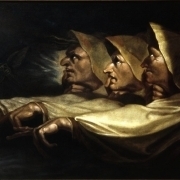
Ban. What are these
So wither'd and so wild in their attire,
That look not like the inhabitants o' the earth,
And yet are on't? Live you? or are you aught
That man may question? You seem to understand me,
By each at once her choppy finger laying
Upon her skinny lips: you should be women,
And yet your beards forbid me to interpret
That you are so.
Macbeth, 1.3.39-47
Ask any casual audience of Macbeth to pick the Weird Sisters out of a line-up, and you are highly unlikely to have them finger the only sixteenth-century visual depiction of the sisters, which appeared in Holinshed’s Chronicles. Before Shakespeare, the Weird Sisters were beautiful wonders in marvelous apparel, beings from another world: nymphs, fairies, or goddesses of destiny. But Shakespeare reupholstered the Weird Sisters in the iconography of witches, their bodies made wrinkled and withered and their surroundings gloomy and grotesque. In Holinshed’s Chronicles, as in Shakespeare’s play, the sisters call Macbeth “Thane of Glamis,” “Thane of Cawdor,” and “King of Scotland,” but then, in Holinshed, they vanish from the story of Macbeth’s bloody rise to the throne. In contrast, Shakespeare brought the sisters back, adding an element of calamity to the felicity in their prophecies by attributing to the Weird Sisters the prophecies of Macbeth’s death – that he would not be killed by any man born of a woman, nor until Birnam wood came to Dunsinane – prophecies which Holinshed ascribed to some random witch, not the Weird Sisters. In sum, where the British chronicles before Shakespeare depicted the Weird Sisters as magical and even beautiful beings speaking a fixed and felicitous future, the play Macbeth warps the sisters into something hideous while adding an element of tragic irony to their fortune-telling. So why would Shakespeare turn the Weird Sisters’ beauty to ugliness, and add tragedy to their prophecies of prosperity? In the context of King James’s recent coronation in 1603, it may be that Shakespeare made the Weird Sisters ugly to illustrate how unattractive the world becomes under the Calvinist doctrine of predestination, which James endorsed, a theology that must disconnect truth and beauty. If predestination is true, it is an ugly truth, which Shakespeare showed by announcing the incontrovertible tragedy of Macbeth through the prophecies of hideous hags. In fact, this was not the first time Shakespeare had stigmatized the tragic chorus of a play by making her unnaturally old and ugly: he did the same thing to Old Queen Margaret in Richard III, characterizing the Tudor myth she speaks as old and ugly by making her a withered hag. In other words, although Shakespeare spent much of his career satirizing the folly of stigma, he himself was not above employing the representational resources of stage stigma, specifically the imagery of old age, in the cases of Margaret and the Weird Sisters.
Context
The Weird Sisters in Early British Literature
Witches on the Jacobean Stage
Witches in Shakespeare
Ugliness in Shakespeare
Bibliography
Robinson, Ian. “The Witches and Macbeth.” Critical Review 11 (1968): 101-05.
Shamas, Laura. “From Goddess to Witch.” We Three: The Mythology of Shakespeare’s Weird Sisters. New York, NY: Peter Lang, 2007. 9-33.
Clark, Sandra. “Macbeth and the Weird Sisters.” Shakespeare Studies 46 (2008): 62-76.
Spoto, Stephanie Irene. "Jacobean Witchcraft and Feminine Power." Pacific Coast Philology 45 (2010): 53-70.
Sen Gupta, Subhajit. "'You should be women': Witchcraft and Forms of Subversion in Macbeth." Journal of Drama Studies 4.2 (2010): 87-100.